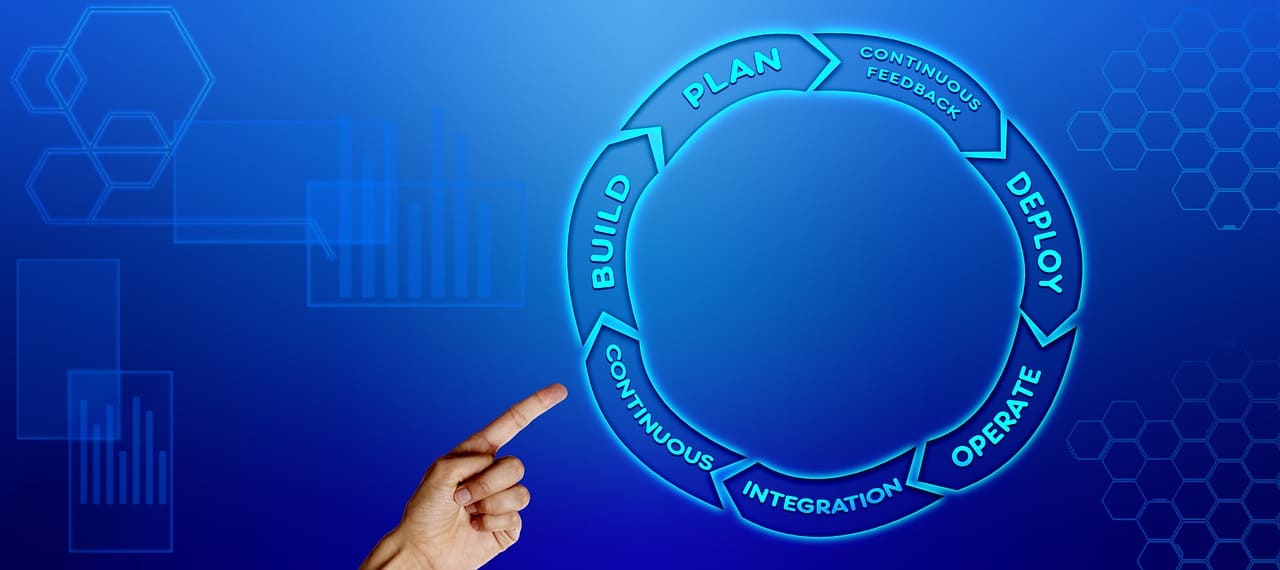
DevOps
Let’s travel into the distant past, to the year 2007. Practically the Stone Age. At that time, the IT community began to worry about a certain connection: the tie between those who wrote software and those who deployed and supported it was growing rather thin. This could have led to a fatal level of dysfunction.
Fortunately, in 2009, Belgian consultant Patrick Debois launched DevOps Days. The conference gave birth to the idea (and the term) of bringing software development (Dev) and IT operations (Ops) closer together. Needless to say, it caught on.
The aim of this methodology is to improve and shorten the systems development life cycle. Today, in 2023, it’s growing ever stronger. New ways of working are emerging on a regular basis. If you’re wondering what are the most exciting DevOps trends in 2023, please, do read on.
DevSecOps and better security
DevOps consists of the marriage between development and operations. Yet, in 2023, it seems necessary to bring a third element into the equation, namely security. It’s easily one of the biggest concerns of the digital age. Denial-of-Service (DoS) attacks, malware, and Corporate Account Takeover (CATO) all require prevention.
Instead of addressing them after development is pretty much done, why not integrate security practices from the get-go? The earlier in the software development life cycle (SDLC), the better. Such a tailor-made approach can ultimately enable faster roll-out.
Application security testing (AST) tools include static application security testing (SAST) and software composition analysis (SCA). Interactive application security testing (IAST) and dynamic application security testing (DAST) are also commonly used.
One of the stronger DevOps trends in 2023, DevSecOps has many uses. In the automotive industry, it helps meet compliance standards such as MISRA and AUTOSAR. In healthcare, it maintains much-needed privacy and security of sensitive patient data.
Serverless computing and the cloud
Of course, it’s next to impossible to talk about DevOps trends in 2023 without touching on the cloud. Both development and operations are becoming increasingly reliant on serverless computing. With hybrid and remote working, this trend is only going to continue growing.
The cloud is a great way to generate DevOps pipeline code without the need for complex infrastructure. You can develop, test, and deploy efficiently, without having to own any of the servers. Due to the absence of a single point of failure, the cloud also makes everything a lot more secure.
Still, this approach may not suit all developers. After all, data legislation regulations are different in each area which can pose an obstacle. However, due to lower costs, the possibility of globalized working patterns, and good scalability, DevOps and the cloud will remain interlinked for a long time.
Low-code applications
Another innovation that seems to be making everyone’s lives easier is the low-code approach. It does exactly what it says on the tin — lets you design applications without any major coding skills. It’s pretty much a drag-and-drop way of working. You can sketch out a rough idea in a matter of hours. A great solution for those with a vision but not enough coding experience.
The simplistic and user-friendly visual interface is surprisingly powerful. The low-code approach improves the workflow by shortening the initial phase. Once the idea is there, more experienced developers can work to perfect it. The method allows for a faster transition from software development to IT operations. Such agility gives any DevOps team a competitive edge in the fast-paced software market of today.
Artificial intelligence and machine learning
When it comes to DevOps trends in 2023, it’s easy to see a common thread. Cross-pollination between different technologies and approaches to creating and running apps is the way to go. Artificial intelligence (AI) and machine learning (ML) are no exception. Despite some concerns around the two, they are becoming extremely popular. AI and ML have their use in customer service, writing college-level papers, complex digital diagnostics, augmented reality, and a huge etcetera.
So what does this mean for the world of DevOps? AIOps automates IT processes and operations, identifying problems and solving them on the go. MLOps, on the other hand, strengthens the development system of machine learning, optimizing operations and enhancing productivity. All this, in turn, improves quality assurance.
The rise of Kubernetes
Possibly the most well-known of the lot, this is a trend that is one to watch out for. Also known as K8, Kubernetes is a portable open-source platform. It’s extensible and focused on helping manage containerized services and workloads. This container-based ecosystem is continuous and autonomous. Developers can use it to scale up or down, depending on the needs of the client.
This open-source container orchestration system can also facilitate cross-functional action. One of its greatest perks is its ability to enhance operational efficiency while minimizing deployment downtime. Oh, and one more thing for those who are wondering — Kubernetes means ‘helmsman’ or ‘pilot’ in Ancient Greek.
Let’s not forget GitOps
Last but not least, it’s good to acknowledge GitOps as potentially one of the major DevOps trends in 2023. It’s an offshoot of the already mentioned Kubernetes paradigm which helps monitor, control, and automate infrastructure.
Git itself is a distributed version control system that has been around since 2005. It lets development teams have multiple local copies of the project’s codebase. These can exist independently from each other. When combined with DevOps best practices, it works well in version control, collaboration, CI/CD, and compliance. Definitely an addition to the DevOps arsenal you will want to watch out for.
Embracing the DevOps trends in 2023
This is promising to be an exciting year. The relationship between software development and IT operations is growing ever stronger. New trends are bringing improvements to the already dynamic landscape. DevSecOps looks to deliver greater online safety and security. We’re also seeing an increased emphasis on serverless computing, with a good chunk of the data and processes being transferred onto the cloud.
Low-code applications are giving even those with limited experience a chance to turn their visions into reality. The introduction of artificial intelligence (AI) and machine learning (ML) can help detect and mitigate problems and improve functionality. Kubernetes and the closely related GitOps complete the list of DevOps trends in 2023.
Of course, there are many other new capabilities available out there. The ones listed above, however, are the strongest contenders for trends that will make waves in 2023. It’s the perfect time to take advantage of their potential.






